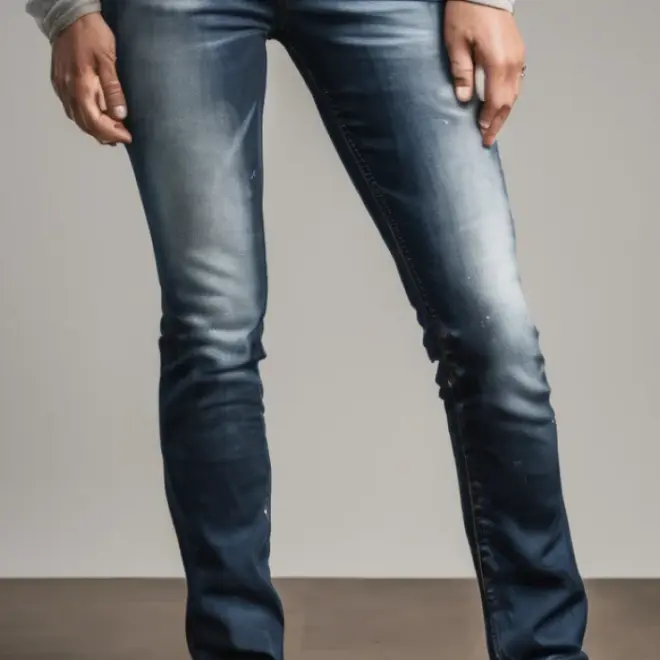Quick Summary: Remove mustard stains from jeans effectively by acting fast! Blot the stain, pretreat with a stain remover or liquid detergent, let it sit, and then wash as usual. For stubborn stains, a diluted bleach solution or enzyme cleaner can work wonders on lighter denim. Always check fabric care labels.
Oh, the dreaded mustard stain! It happens to the best of us – a picnic, a hot dog gone rogue, or a culinary experiment that splatters. Jeans are our go-to, reliable wardrobe staple, and the thought of a bright yellow stain ruining them can be a real downer. But don’t worry! Dealing with mustard on denim is usually quite manageable, especially if you tackle it promptly. This guide will walk you through simple, proven methods to get your favorite jeans looking as good as new, so you can wear them with confidence and without a worry.
The Science Behind Mustard Stains on Denim
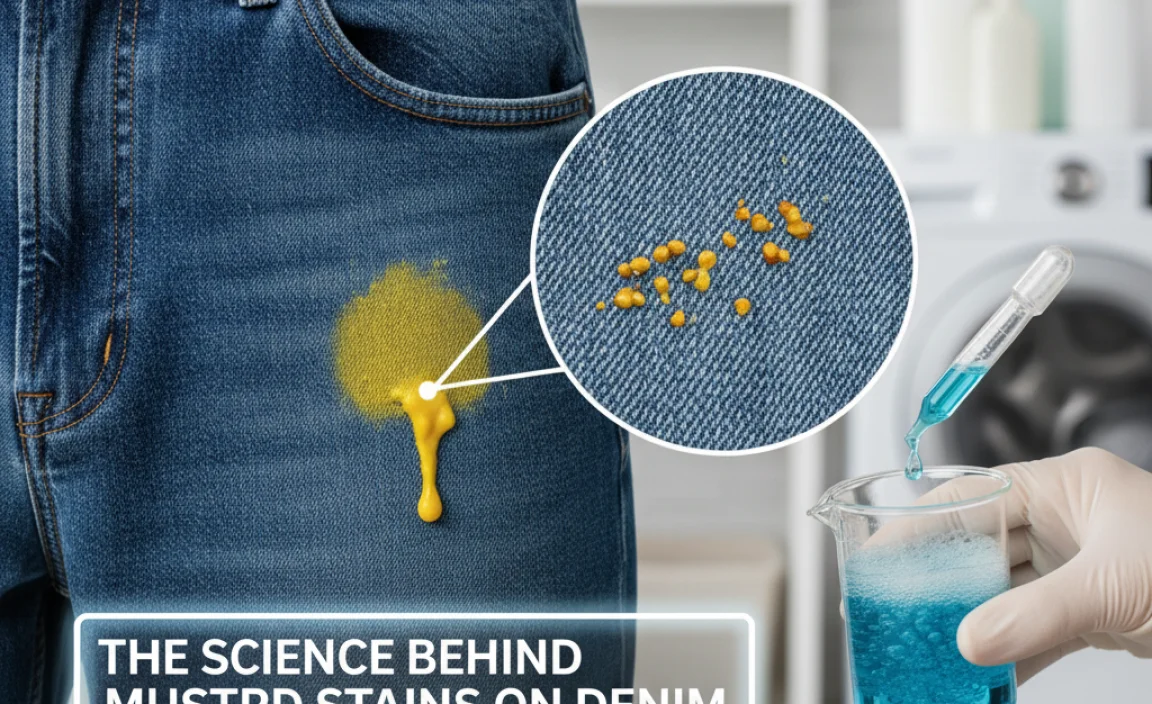
Mustard’s staining power comes primarily from its main ingredient: turmeric. Turmeric contains a powerful pigment called curcumin, which is a natural dye. When this pigment comes into contact with fabric, it can bind to the fibers, making it stubborn to remove. Additionally, mustard often contains vinegar (an acid) and oil, which can further complicate stain removal by setting the pigment deeper into the fabric or spreading the stain.
Understanding this helps us approach the problem strategically. We need methods that can lift the pigment, break down any fatty components, and neutralize the acidity without damaging the denim. Fortunately, common household items and readily available laundry products are incredibly effective. It’s less about a magic bullet and more about applying the right techniques in the right order.
Immediate Action: The First Line of Defense
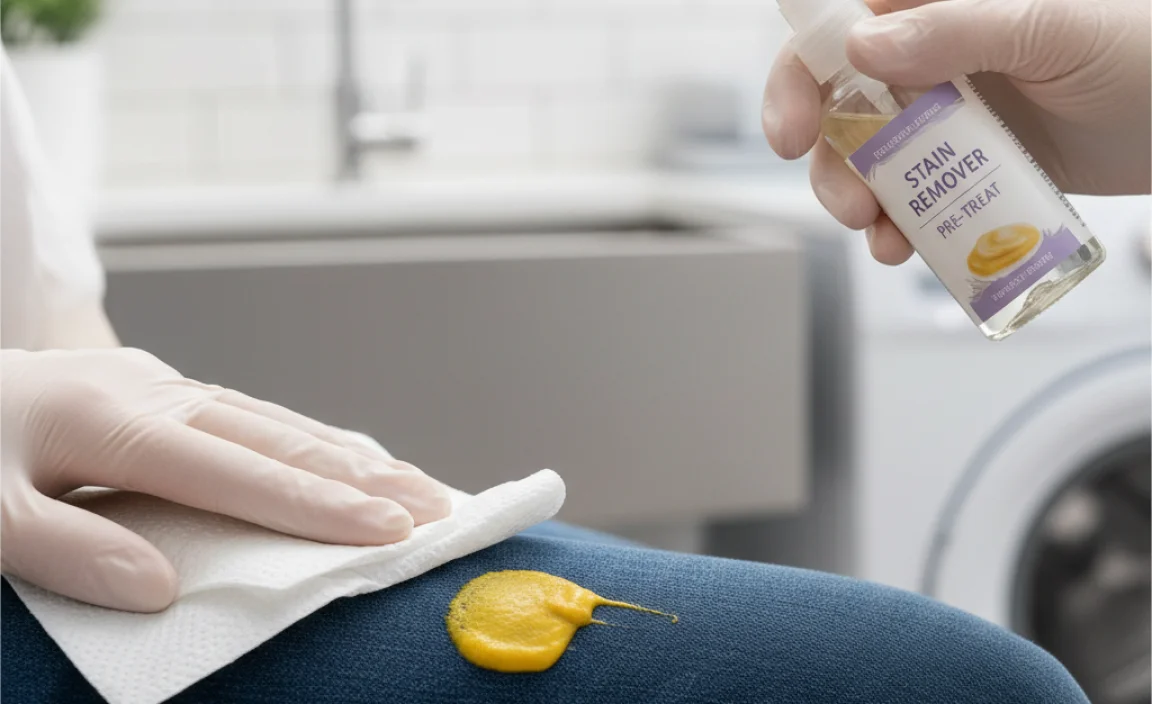
The most crucial step in removing any stain, especially mustard, is speed. The longer the stain sits, the deeper it penetrates the denim fibers, making it significantly harder to lift. As soon as you notice a mustard stain on your jeans, it’s time to act.
Step 1: Blot, Don’t Rub
Using a clean, dry cloth, paper towel, or sponge, gently blot the stained area. The goal here is to absorb as much of the excess mustard as possible. Be careful not to spread the stain further by rubbing. Think of it like dabbing a fresh spill – you want to lift it off the surface.
Tools You’ll Need for This Step:
- Clean, dry cloths (white is best to avoid color transfer)
- Paper towels
- Sponge
Step 2: Cold Water Rinse (If Possible)
If you can, immediately rinse the stained area with cold water from the backside of the fabric. This helps to push the stain out of the fibers rather than driving it deeper. Hot water can set protein and pigment stains, so always opt for cold when dealing with fresh spills, especially on colored fabrics like denim.
Important Note: Avoid using hot water on fresh mustard stains. It can cook the pigment into the fabric, making removal much more difficult.
Pre-Treating the Stain: Your Stain-Fighting Arsenal
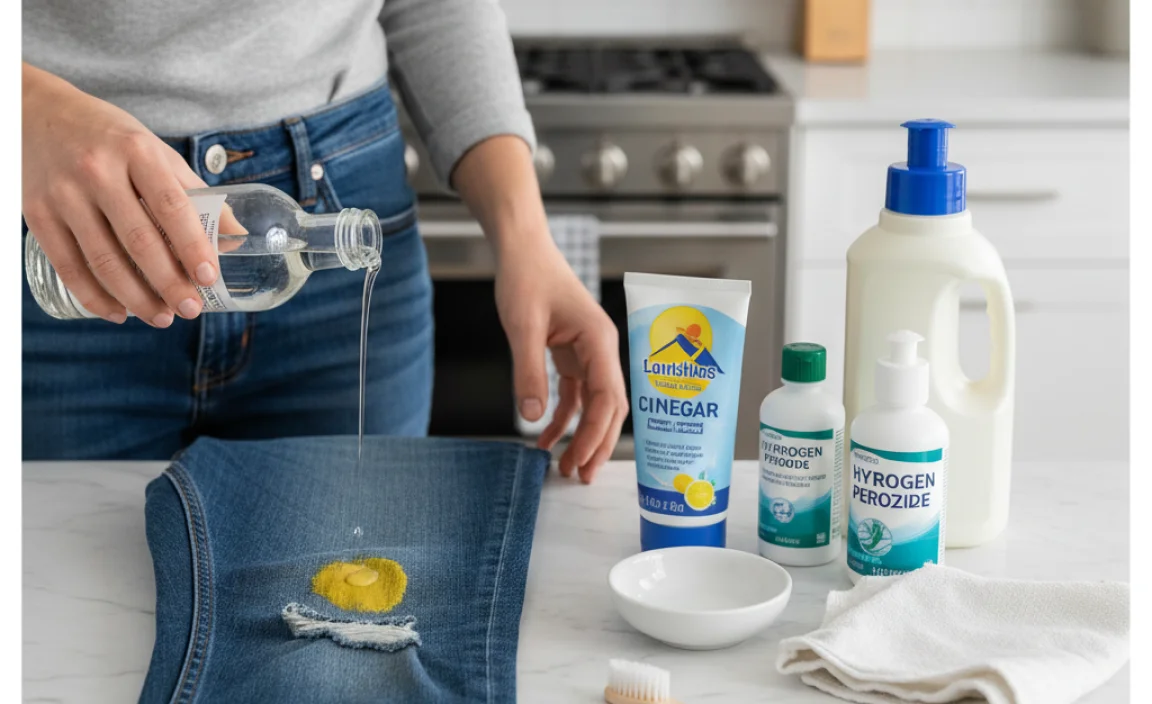
Once you’ve blotted and rinsed, it’s time to pre-treat the stain before it goes into the washing machine. This step is vital for breaking down the stain components and ensuring a cleaner wash.
Method 1: Liquid Laundry Detergent
Liquid laundry detergent is an excellent first line of defense because it contains surfactants that help lift stains and break down grease. Many detergents also contain enzymes that are particularly effective at tackling organic stains like mustard.
- Apply a small amount of liquid laundry detergent directly onto the mustard stain.
- Gently rub the detergent into the fabric with your fingers or a soft-bristled brush (like an old toothbrush). Work it into the stain from both sides of the fabric.
- Let the detergent sit on the stain for at least 5-10 minutes, or longer for tougher stains (up to 30 minutes).
Method 2: Dish Soap
Dish soap, especially those designed for grease removal, can be surprisingly effective on certain components of mustard stains, particularly any oily residue.
- Apply a few drops of grease-cutting dish soap directly to the stain.
- Gently work it into the fabric.
- Let it sit for about 15 minutes before rinsing with cold water.
Method 3: Stain Remover Sprays/Sticks
Commercial stain removers are formulated with powerful cleaning agents and enzymes designed to tackle a wide range of stains. They are a convenient and often very effective option.
- Follow the instructions on the stain remover product.
- Typically, you’ll spray or apply the remover directly to the stain.
- Allow it to penetrate the fabric for the recommended time (usually 5-15 minutes).
For an in-depth look at stain removers, the U.S. Environmental Protection Agency offers insights into greener cleaning product options and their effectiveness, which can be useful when selecting a product.
When the Stain Persists: Advanced Stain-Fighting Techniques
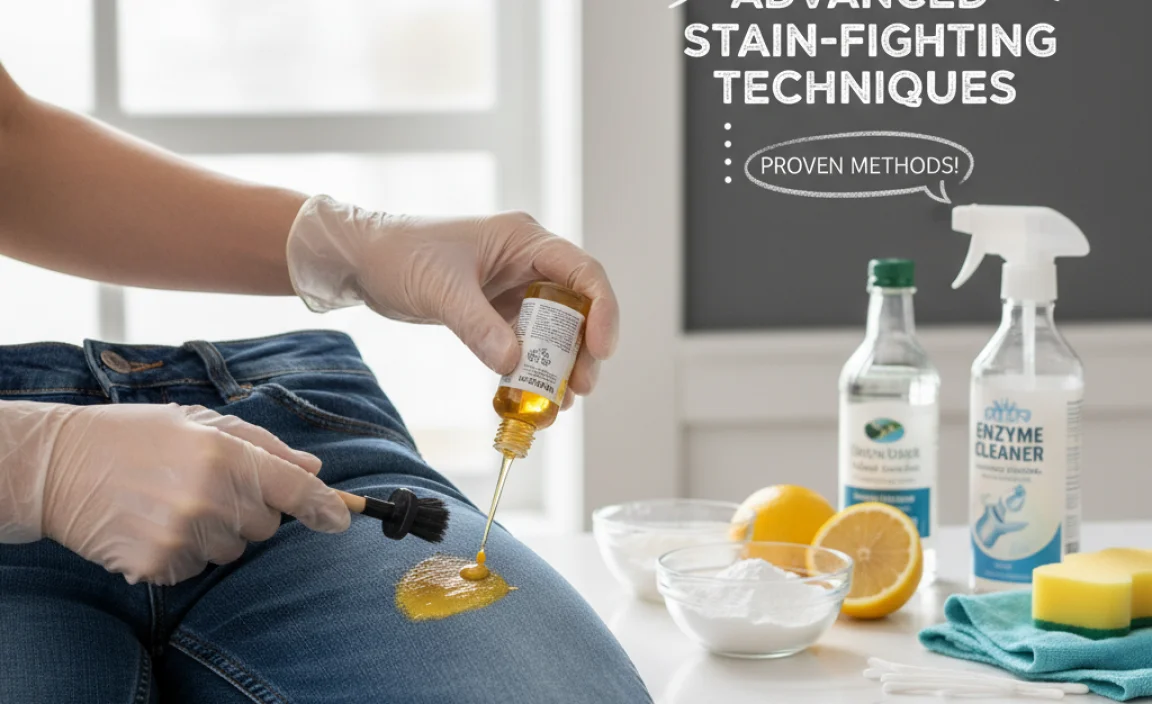
If, after pre-treating and washing, you still see remnants of the mustard stain, don’t despair. There are stronger methods you can try. Always remember to test these methods on an inconspicuous area of your jeans first to ensure they don’t cause discoloration or damage.
Method 4: Enzyme Cleaners
Enzyme cleaners are fantastic for organic stains. They contain specific enzymes that break down protein-based and organic matter. Mustard’s turmeric and other natural components fall into this category.
- Purchase an enzyme-based laundry pre-treater or cleaner.
- Apply it to the stained area according to product directions.
- Allow it to soak for a period, as recommended, often for 30 minutes to several hours, or even overnight for very stubborn stains.
- Wash as usual.
Method 5: Diluted White Vinegar Solution
Vinegar is a mild acid that can help break down the turmeric pigment. Its acidity can lift the stain without being overly harsh, especially when diluted.
- Mix equal parts white vinegar and cold water.
- Dab this solution onto the remaining stain.
- Let it sit for about 10-15 minutes.
- Rinse thoroughly with cold water before washing again.
Caution: Never mix vinegar with bleach, as this creates toxic chlorine gas.
Method 6: Hydrogen Peroxide (for White or Light-Colored Jeans)
Hydrogen peroxide is a mild bleaching agent that can be effective on lighter fabrics. Use this with extreme caution on darker denim, as it can cause fading or discoloration.
- Apply 3% hydrogen peroxide directly to the stain.
- Let it sit for a few minutes.
- Rinse thoroughly with cold water.
- Wash immediately.
Tip: You can also create a paste with baking soda and hydrogen peroxide for a slightly more abrasive but still gentle approach on stubborn spots.
Method 7: Diluted Bleach (Colored Jeans – Use with Extreme Caution!)
For 100% white cotton jeans, a diluted bleach solution can be a last resort. For colored jeans, bleach is generally not recommended as it will likely remove the color along with the stain. If attempting this on very light, colorfast denim, ensure it is well-diluted and test on an inside seam first.
- Mix 1 part bleach with 4 parts cold water.
- Apply the solution very carefully to the stain using a cotton swab or cloth.
- Let it sit for no more than 5 minutes.
- Rinse immediately and thoroughly with cold water.
- Wash the jeans as usual.
The Centers for Disease Control and Prevention (CDC) provides essential safety guidelines for using household cleaning products like bleach, emphasizing proper ventilation and avoiding mixing chemicals.
Washing and Drying: The Final Steps

After pre-treating and spot-treating, it’s time to launder your jeans. The way you wash and dry can either set a lingering stain or help lift it completely.
Step 1: Machine Wash
Wash your jeans on a normal cycle using cold or lukewarm water and your regular detergent. If you’re concerned about the stain, you can add a laundry booster or oxygen bleach to the wash.
Step 2: Inspect Before Drying
This is a CRITICAL step. Before putting your jeans in the dryer, check the stained area carefully in good light. If any trace of the stain remains, do NOT put the jeans in the dryer. The heat from the dryer will permanently set the stain, making it nearly impossible to remove.
Step 3: Air Dry if Necessary
If the stain is still visible, repeat the pre-treatment and washing steps. It’s better to air dry your jeans while you continue to work on the stain than to set it permanently with dryer heat. Once you are completely satisfied the stain is gone, you can then machine dry your jeans according to their care label.
Understanding Denim Care Labels
Always refer to your jeans’ care label before attempting any stain removal or washing. These labels provide specific instructions from the manufacturer regarding water temperature, bleach use, and drying methods. Ignoring them can lead to irreversible damage to your denim.
A typical care label might look something like this simplified example:
| Symbol / Instruction | Meaning | Applicability to Mustard Stains |
|---|---|---|
| Machine wash, maximum water temperature 30°C (86°F) | Use cold or lukewarm water for washing. | |
| Do not bleach | Avoid chlorine bleach. Consider oxygen bleach or enzyme cleaners. | |
| Tumble dry, low heat | Dry on low heat only after stain is completely removed. Start with air dry if unsure. | |
| Iron, medium temperature | Can iron on medium heat. Avoid ironing over any remaining stain. |
(Note: Actual care labels use standardized pictograms. Images above are illustrative examples.)
Always prioritize the instructions on your garment’s tag to maintain the integrity and longevity of your jeans.
FAQs: Your Mustard Stain Questions Answered
Q1: Can I use hot water to remove a mustard stain from my jeans?
No, it’s best to avoid hot water on fresh mustard stains. Hot water can help set the stain, making it harder to remove. Always start with cold water.
Q2: How long should I let the stain remover soak in?
It depends on the product and the severity of the stain. Most commercial stain removers suggest 5-15 minutes. For tougher stains with DIY methods like detergent or enzyme cleaners, you can often let it soak for 30 minutes to a few hours, or even overnight in some cases.
Q3: My jeans are dark blue. Can I use hydrogen peroxide or bleach?
Be very cautious. Hydrogen peroxide and bleach are bleaching agents and can lighten or remove color from dark denim. It’s best to try less aggressive methods first, like liquid detergent or enzyme cleaners. If you must use peroxide or diluted bleach, test on an inconspicuous spot first and use sparingly.
Q4: What if the stain is old and dried?
Old, dried mustard stains are tougher. You’ll likely need to rehydrate the stain first by soaking the area in cold water for a bit. Then, use a strong enzyme cleaner or a heavy-duty pre-treater, apply it generously, and let it soak for an extended period (several hours or overnight). Multiple treatments might be necessary.
Q5: Can I use a wet wipe on a mustard stain immediately?
A wet wipe can help to blot and remove surface mustard, but it’s not a complete stain remover. Use it to dab the stain while you’re out and about, but be sure to follow up with proper pre-treatment and washing as soon as possible.
Q6: Does salt help with mustard stains?
Salt is often recommended for fresh liquid spills to absorb moisture. While it can help with the immediate absorption of some of the excess mustard liquid, it doesn’t actively break down the stain itself and isn’t a substitute for proper pre-treatment with detergent or a stain remover.
Q7: My jeans are a blend (e.g., cotton-poly). Does that change how I treat the stain?
Denim blends are generally quite durable, but always check the care label. The basic principles of blotting, pre-treating, and washing still apply. Synthetic blends may sometimes be more prone to setting stains, so prompt action and careful inspection before drying are even more important.
Conclusion: Keeping Your Denim Stain-Free
Mustard stains on jeans might seem daunting, but with a little knowledge and the right approach, they are almost always conquerable. Remember, the key is to act quickly, blot instead of rub, pre-treat effectively, and always, always check the stain before drying.
From simple liquid detergents to more specialized stain removers, you now have a range of tools and techniques at your disposal. Don’t let a little yellow condiment get you down. Follow these steps, stay patient, and your favorite pair of jeans will be back in rotation, ready for whatever adventures come your way. Happy stain fighting!







